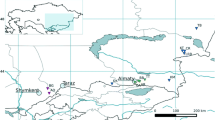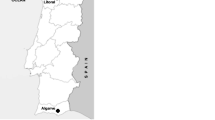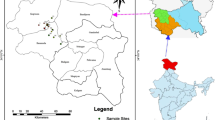Abstract
In the present study genetic diversity and hybridization with cultivars were investigated in a population of the endangered European wild apple species Malus sylvestris (L.) Mill. with the aim to establish a basis for the implementation of conservation activities and to ensure its long-term preservation. A total of 284 putative M. sylvestris trees located in the East Ore Mountains were investigated along with a standard set of reference apple genotypes proposed by the European Cooperative Program for Plant Genetic Resources (ECPGR) and 13 old apple cultivars often cultivated in Saxony. The genetic analysis was performed using 12 microsatellite markers also recommend by the ECPGR. To differentiate ‘true type’ M. sylvestris individuals, hybrids and apple cultivars (Malus × domestica Borkh.) a model-based cluster analysis was performed using STRUCTURE. Two clusters were identified consisting of M. sylvestris and M. × domestica genotypes. About 40 % of the putative M. sylvestris showed an admixture of the species-specific allele frequencies and were defined as hybrids. The genetic diversity of the ‘true type’ M. sylvestris population was still high but slightly lower than in the apple cultivars especially since some SSR loci were fixed on one or few alleles in the M. sylvestris population. The differentiation parameters between ‘true type’ wild apple and cultivars indicated a clear discrimination between the wild and cultivated apple individuals. This fact confirms our expectation of the existence of ‘true type’ M. sylvestris individuals in the East Ore Mountains and argues for the realization of preservation measures in this area.


Similar content being viewed by others
Abbreviations
- ECPGR:
-
European Cooperative Program for Plant Genetic Resources
- HWE:
-
Hardy–Weinberg equilibrium
References
Allendorf FW, Leary RF, Spruell P, Wenburg JK (2001) The problems with hybrids: setting conservation guidelines. Trends Ecol Evol 16:613–622
Broothaerts W (2003) New findings in apple S-genotype analysis resolve previous confusion and request the re-numbering of some S-alleles. Theor Appl Genet 106:703–714
Castiglione S, Cicatelli A, Lupi R, Patrignani G, Fossati T, Brundu G, Sabatti M, van Loo M, Lexer C (2010) Genetic structure and introgression in riparian populations of Populus alba L. Plant Biosyst 144:656–668
Cavanna M, Marinoni DT, Bounous G, Botta R (2008) Genetic diversity in ancient apple germplasm from northwest Italy. J Hortic Sci Biotech 83:549–554
Chapuis MP, Estoup A (2007) Microsatellite null alleles and estimation of population differentiation. Mol Biol Evol 24(3):621–631
Chybicki I, Burczyk J (2009) Simultaneous estimation of null alleles and inbreeding coefficients. J Hered 100:106–113
Coart E, Vekemans X, Smulders MJM, Wagner I, Van Huylenbroeck J, Van Bockstaele E, Roldan-Ruiz I (2003) Genetic variation in the endangered wild apple (Malus sylvestris (L.) Mill.) in Belgium as revealed by amplified fragment length polymorphism and microsatellite markers. Mol Ecol 12:845–857
De Nettancourt D (2001) Incompatibility and incongruity. In: Wild and cultivated plants. Springer, Berlin
Degen B (2008) GDA_NT 2.0: Genetic data analysis and numerical tests. Available from: bernd.degen@vti.bund.de
Dreesen RSG, Vanholme BTM, Luyten K, Van Wynsberghe L, Fazio G, Roldan-Ruiz I, Keulemans J (2010) Analysis of Malus S-RNase gene diversity based on a comparative study of old and modern apple cultivars and European wild apple. Mol Breed 26:693–709
Ellstrand NC, Elam DR (1993) Population genetic consequences of small population-size—implications for plant conservation. Annu Rev Ecol Syst 24:217–242
Evans KM, Fernandez-Fernandez F, Laurens F, Feugey L, van de Weg WE (2007) Harmonising fingerprinting protocols to allow comparisons between germplasm collections—Malus/Pyrus. XIIth EUCARPIA Symposium on Fruit Breeding and Genetics. Zaragoza (Espagne) 16–20 September 2007 (poster)
Fellenberg U (2001) Beurteilung von Wildobst-Voraussetzung für geeignetes Vermehrungsgut zur Erhaltung von Waldgenressourcen. Forst und Holz 56:50–54
Gharghani A, Zamani Z, Talaie A, Oraguzie NC, Fatahi R, Hajnajari H, Wiedow C, Gardiner SE (2009) Genetic identity and relationships of Iranian apple (Malus × domestica Borkh.) cultivars and landraces, wild Malus species and representative old apple cultivars based on simple sequence repeat (SSR) marker analysis. Genet Resour Crop Ev 56:829–842
Gregorius HR (1974) Genetischer Abstand zwischen Populationen. I. Zur Konzeption der genetischen Abstandsmessung. Silvae Genet 23:22–27
Guarino C, Santoro S, De Simone L, Lain O, Cipriani G, Testolin R (2006) Genetic diversity in a collection of ancient cultivars of apple (Malus × domestica Borkh.) as revealed by SSR-based fingerprinting. J Hortic Sci Biotech 81:39–44
Hedrick PW (2005) Genetics of populations. Jones and Bartlett Publishers, Sudbury
Hoebee SE, Arnold U, Duggelin C, Gugerli F, Brodbeck S, Rotach P, Holderegger R (2007) Mating patterns and contemporary gene flow by pollen in a large continuous and a small isolated population of the scattered forest tree Sorbus torminalis. Heredity 99:47–55
Hokanson SC, Szewc-McFadden AK, Lamboy WF, McFerson JR (1998) Microsatellite (SSR) markers reveal genetic identities, genetic diversity and relationships in a Malus × domestica Borkh. core subset collection. Theor Appl Genet 97(5–6):671–683
Höltken AM, Tähtinen J, Pappinen A (2003) Effects of discontinuous marginal habitats on the genetic structure of common ash. Silvae Genet 52:206–212
Kleinschmit J (1998) Erhaltung und Nutzung wertvoller Edellaubbaumarten. Forst und Holz 17:515–519
Kleinschmit J, Stephan R (1997) Wild fruit trees. EUFORGEN Noble Hardwoods, Network, Reports, pp 51–59
Koopman WJM, Li YH, Coart E, De Weg EV, Vosman B, Roldan-Ruiz I, Smulders MJM (2007) Linked vs. unlinked markers: multilocus microsatellite haplotype-sharing as a tool to estimate gene flow and introgression. Mol Ecol 16:243–256
Larsen AS, Kjaer ED (2009) Pollen mediated gene flow in a native population of Malus sylvestris and its implications for contemporary gene conservation management. Conserv Genet 10:1637–1646
Larsen A, Asmussen C, Coart E, Olrik D, Kjær E (2006) Hybridization and genetic variation in Danish populations of European crab apple. J Tree Genet Genomes 2:86–97
Larsen AS, Jensen M, Kjaer ED (2008) Crossability between wild (Malus sylvestris) and cultivated (M. × domestica) apples. Silvae Genet 57:127–130
Liebhard R, Gianfranceschi L, Koller B, Ryder CD, Tarchini R, van de Weg E, Gessler C (2002) Development and characterization of 140 new microsatellites in apple (Malus × domestica Borkh.). Mol Breed 10(4):217–241
Natzke E, Pech M (1998) Die seltenen Baumarten Wildbirne und Wildapfel in Sachsen-Anhalt. In: Kleinschmit J, Soppa B, Fellenberg U. Die Wildbirne, Pyrus pyraster (L.) Burgsd. Schriften der Forstlichen Fakultät der Universität Göttingen und der Niedersächsischen Forstlichen Versuchsanstalt 125: 113–114
Nei M (1972) Genetic distance between populations. Am Nat 106:p283
Nei M (1973) Analysis of gene diversity in subdivided populations. P Natl A Sci 70:3321–3323
Patzak P (2003) Förderung von Wildobst und Feldulme. Beitrag zum Erhalt der Artenvielfalt der Auewälder im Biosphärenreservat Flusslandschaft Mittlere Elbe. Naturwissenschaftliche Beiträge, Museum Dessau 15: 21–43
Paul M, Hinrichs T, Janssen A, Schmitt HP, Stephan BR, Dörflinge H (2000) Concept for the conservation and sustainable utilization of forest genetic resources in the Federal Republic of Germany. Sächsische Landesanstalt für Forsten, Pirna
Peakall R, Smouse PE (2006) GENALEX 6: genetic analysis in Excel. Population genetic software for teaching and research. Mol Ecol Notes 6:288–295
Pritchard JK, Stephens M, Donnelly P (2000) Inference of population structure using multilocus genotype data. Genetics 155:945–959
Reim S, Flachowsky H, Michael M, Hanke MV (2006) Assessing gene flow in apple using a descendant of Malus sieversii var. sieversii f. niedzwetzkyana as an identifier for pollen dispersal. Environ Biosafety Res 5:89–104
Reim S, Proft A, Heinz S, Höfer M (2011) Diversity of the European indigenous wild apple Malus sylvestris (L.) Mill. in the East Ore Mountains, Germany: I. Morphological characterization. Genet Resour Crop Evol. doi:10.1007/s10722-011-9746-x
Remmy K, Gruber F (1993) Untersuchung zur Verbreitung und Morphologie des Wild-Apfels (Malus sylvestris (L.) Mill.). Mitt Deut Dendr Gesells. 81:71–94
Rhymer JM, Simberloff D (1996) Extinction by hybridization and introgression. Annu Rev Ecol Syst 27:83–109
Rieseberg LH, Ellstrand NC (1993) What can molecular and morphological markers tell us about plant hybridization. Crit Rev Plant Sci 12:213–241
Robinson J, Harris SA, Juniper BE (2001) Taxonomy of the genus Malus Mill. (Rosaceae) with emphasis on the cultivated apple, Malus domestica Borkh. Plant Syst Evol 226:35–58
Rosenthal G (2003) Bedeutung evolutionsbiologischer Prozesse für Landschaftsplanung und Naturschutz. Natur und Landschaft 78:497–506
Sharma G, Bashir R (2007) Effect of different mode of pollination on fruit set and retention in apple (Malus x domestica) cultivars. Indian J Agr Sci 77:509–511
Silfverberg-Dilworth E, Matasci CL, Van de Weg WE, Van Kaauwen MPW, Walser M, Kodde LP, Soglio V, Gianfranceschi L, Durel CE, Costa F, Yamamoto T, Koller B, Gessler C, Patocchi A (2006) Microsatellite markers spanning the apple (Malus × domestica Borkh) genome. Tree Genet Genomes 2(4):202–224
Slotta TAB, Brady L, Chao S (2008) High throughput tissue preparation for large-scale genotyping experiments. Mol Ecol Resour 8:83–87
Spearman C (1904) The proof and measurement of association between two rings. Am J Psychol 15:72–101
Van Oosterhout C, Weetman D, Hutchinson WF (2006) Estimation and adjustment of microsatellite null alleles in nonequilibrium populations. Mol Ecol Notes 6:255–256
Wagner I (1996) Zusammenstellung morphologischer Merkmale und ihrer Ausprägung zur Unterscheidung von Wild- und Kulturformen des Apfels (Malus) und des Birnbaumes (Pyrus). Mitt Deut Dendr Gesells. 82:87–108
Wagner I (2006) Malus sylvestris. Enzyklopädie der Holzgewächse 42:1–16
Watano Y, Kanai I, Tani N (2004) Genetic structure of hybrid zones between Pinus pumila and P. parviflora var. Pentaphylla (Pinaceae) revealed by molecular hybrid index analysis. Am J Bot 91:65–72
Wright S (1951) Genetical structure of populations. Nature 166:247–249
Wright S (1965) The interpretation of population structure by F-statistics with special regard to systems of mating. Evolution 19(3):395–420
Wright S (1978) Evolution and the genetics of populations. University of Chicago Press, Chicago
Yeh F, Yang R, Boyle T, Ye Z, Xian M (2000) Pogene version 1.31. University of Alberta, Edmonton
Acknowledgments
This research project was financial supported by the Federal Agency for Agriculture and Food for (06BM 002/2). We thank very much all volunteers from the Green League East Ore Mountains e.V. for their extensive work on the Malus sylvestris trees in the East Ore Mountains. We also thank Claudia Wiedow for her helpful comments.
Author information
Authors and Affiliations
Corresponding author
Rights and permissions
About this article
Cite this article
Reim, S., Höltken, A. & Höfer, M. Diversity of the European indigenous wild apple (Malus sylvestris (L.) Mill.) in the East Ore Mountains (Osterzgebirge), Germany: II. Genetic characterization. Genet Resour Crop Evol 60, 879–892 (2013). https://doi.org/10.1007/s10722-012-9885-8
Received:
Accepted:
Published:
Issue Date:
DOI: https://doi.org/10.1007/s10722-012-9885-8




